From website to local SEO, this in-depth master guide is designed to help franchisors and franchisees grow their website and in-store foot traffic.
When we talk about franchise SEO, there are usually two types of businesses—and with them, SEO goals—we can focus on:
- Franchisors looking to attract more franchisees and/or drive traffic to their franchisees
- Franchisees looking to increase foot traffic at their local branches
This master (or shall we say “monster”) guide is designed for both.
Franchisors will learn how to optimize and grow their website’s SEO to attract prospects and other targeted traffic via search engines.
Franchisees will learn how to combine the website with local SEO strategies to grow visibility for local searches and foot traffic to their local branches.
Meet Digital Spice—the authors of this guide →
Table of Contents
WHAT’S UNIQUE ABOUT FRANCHISE SEO?
Franchise SEO usually refers to a strategy that combines ‘regular’ (let’s call it ‘website’) and local SEO to target relevant non-branded keywords and attract prospects via search engines
- “Prospects” for franchisors can mean prospective franchisees (B2B audiences)
- “Prospects” for franchisees can mean prospective customers/shoppers (B2C audiences)
Franchisors usually require “website” SEO strategies to attract prospective franchisees on search engines. These strategies revolve around website optimization including technical, on-page, and off-page tactics, to increase ranking on search engine results pages (SERPs).
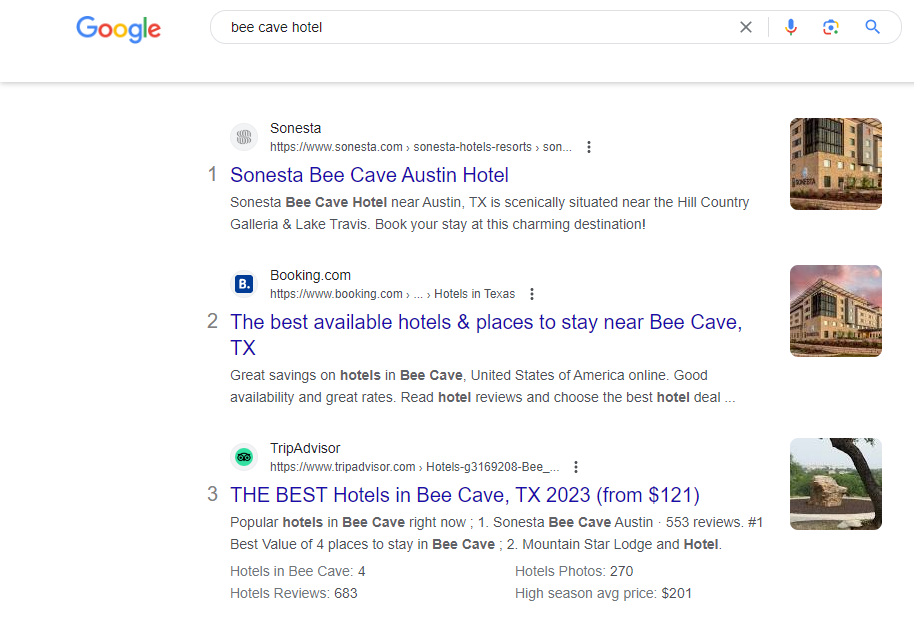
Here’s an example of SERP results for “bee cave hotel” where our client Sonesta occupies the #1 position in July 2023
Franchisees usually require SEO strategies that integrate website SEO with local SEO which means that on top of website optimization and ranking in SERPs, these strategies require Google Business Profile (GBP) optimization and other tactics to rank for local pack and Google map results.
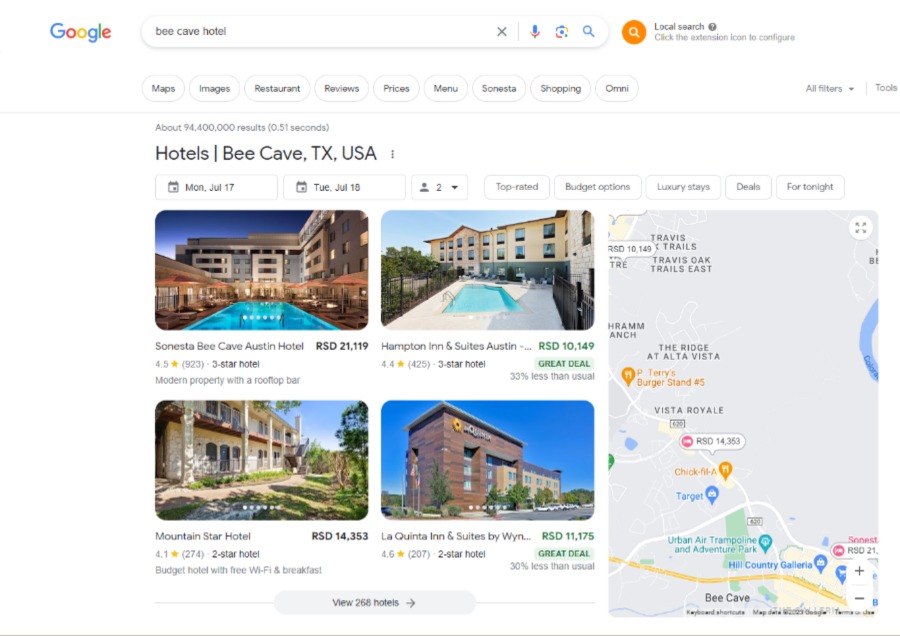
Here’s an example of local pack results for “bee cave hotel” keyword search
If you are a franchisor solely interested in attracting prospective franchisees via search engines, simply focus on our website-related SEO tips and insights and disregard the local SEO recommendations.
WHAT DOES FRANCHISE SEO LOOK LIKE?
Let’s settle on this definition: Franchise SEO is a strategy that combines website and local SEO to grow targeted organic traffic via SERPs and local pack/search results.
What does this mean?
Here’s an example:
If you Google “starbucks nyc,” this will likely be your first result in search engine results pages (SERPs):
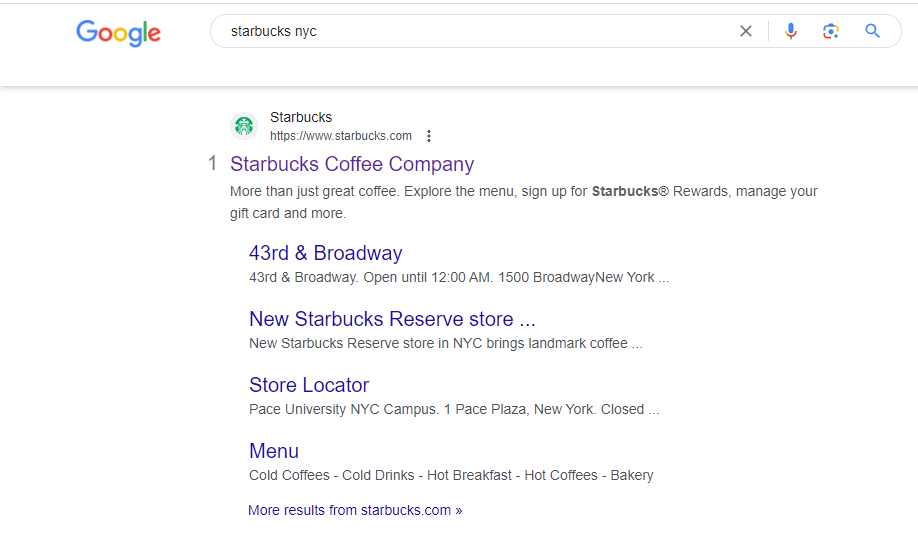
It’s a rich result with a set of links Google pulls from Starbucks’ website to help you explore the brand (ex. Menu) and discover locations (ex. Store Locator).
However, just before this result, you will see a Google Map with a few locations pinned in your focus area like so:

This is called a local pack result and falls under the scope of a local SEO strategy, but more on local SEO later.
As you can imagine, a local pack result is more helpful to users looking for a Starbucks nearby than organic search results below. They can simply click on their best result and map themselves to the location.
In fact, one study found that 78%1 of local searches result in offline store visits and purchases.
Now an important note: As a world-renowned brand. Starbucks will have a ton of branded searches and will naturally occupy the top results in SERPs and local packs.
Brands with lower recognition will use local SEO to rank for non-branded keywords like “coffee shop near me” or “best coffee shops NYC.”
Local SEO is a powerful channel to grow brand awareness, online visibility, and offline conversions.
HOW TO PREPARE FOR FRANCHISE SEO
By now we know that most franchises need two types of SEO: website and local SEO.
Let’s break this down into the key ingredients:
- Website SEO requires a fully optimized website and an SEO content strategy
- Local SEO requires a fully optimized website as well as Google Business Profile (GBP) optimization and management strategy
*A quick reminder: If you are a franchisor using SEO to attract franchisees, focus on our website-related SEO tips.
Let’s start with website SEO.
Part #1. Preparing Your Franchise Website for SEO
Ideally, SEO strategy should factor into your website planning as trying to optimize an existing website that wasn’t built for SEO is more challenging, but not impossible, of course.
Let’s assume that you are planning a new, custom website (which we can help you with, btw!).
To prepare your franchise website for SEO, you’ll need to:
- Define your goals
- Create a keyword strategy
- Map your content
- Optimize your content
- Streamline user journeys
- Create a scalable URL structure
- Test & optimize your core web vitals
Get a free proposal for your custom franchise website →
Here are the actionable steps to take for optimal results:
1. Define your goals
How are you going to measure your website’s SEO performance or, more specifically, impact on your business?
Set measurable goals for your target keyword rankings and organic traffic.
Also, try to assign goals to each phase of the conversion funnel, from organic (SEO) traffic to conversions, for a more holistic overview and future diagnostics.
2. Create a keyword strategy
What keyword best describes your business?
Use this as an umbrella term—or key topic—for your website. For franchisors, this might be “italian franchise restaurant,” while for franchisees, this may simply be “italian restaurant.”
Run your umbrella term through a keyword research tool like Ahrefs or Semrush (we like these, but there are plenty more!) to check whether they are viable, i.e. how many users are searching for these terms per month.
Here are some keyword variants with US search volumes for “italian franchise restaurant:”
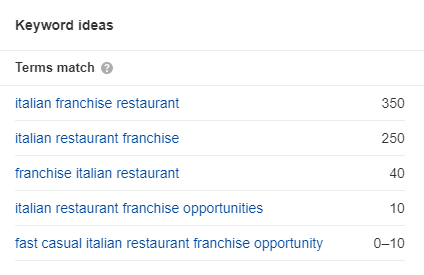
Ahrefs, July 2023
So, if you play your cards right and you manage to assume a top position for this keyword in Google, your total potential US traffic for one keyword would be 350.
Here are some keyword insights for “italian restaurant:”
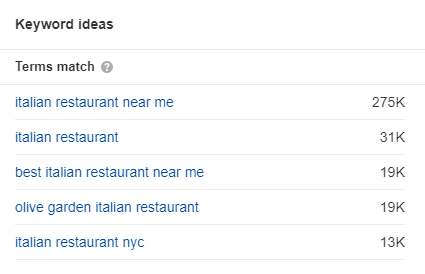
Ahrefs, July 2023
Notice that the top search is “italian restaurant near me.” This is a typical example of a keyword that requires local SEO. Google it and chances are that your top result with be a Google Map with restaurants in your area.
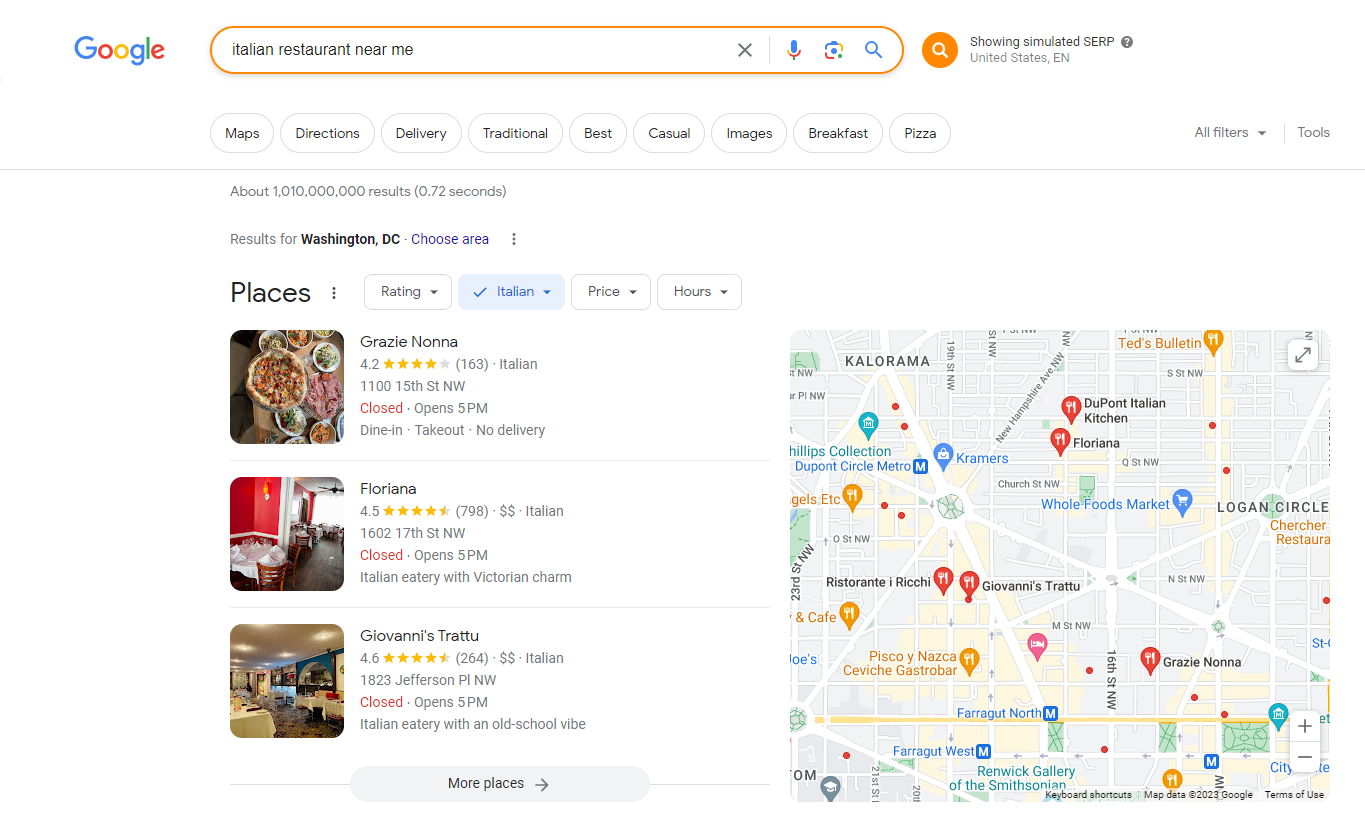
Google results for “italian restaurant near me” in Washington DC, June 2023
Moving along.
Now that you have your umbrella term, you may want to break it down into sub-topics which, in franchise SEO, will usually be locations and brands.
Let’s see what this looks like for franchisees.
Going back to our “italian restaurant” example, you may want to create pages optimized for each of the locations in which you are present. Here’s a quick look at the most searched locations for Italian restaurants in the U.S.
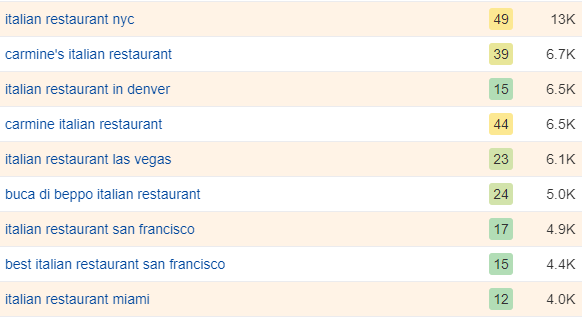
Ahrefs, July 2023 – Respectively from left to right, we have the keyword, the keyword difficulty, and the search volume in the U.S.
Moving over to franchisors and the “italian franchise restaurant” example, we see that users are usually looking for two related categories:
- Brands
- Cuisine sub-type

Ahrefs, July 2023 – Respectively from left to right, we have the keyword, the keyword difficulty and the search volume in the U.S.
How would this translate to the SEO-friendly website structure for franchisors?
You may want to create a category of pages dedicated to your brands and another category of pages dedicated to the types of Italian restaurants you franchise.
- Our Brands
- Brand X
- Brand Y
- Brand Z
- Cuisine
- Casual Dining
- Vegetarian
- Sicilian
3. Map your content
The keyword research exercise will help you understand what your audience is looking for via search engines.
Using these insights, you can begin to plan and map the content on your website—content your audience will find useful.
Start by listing the types of website content you want to use.
Here are the types of content your audience may appreciate:
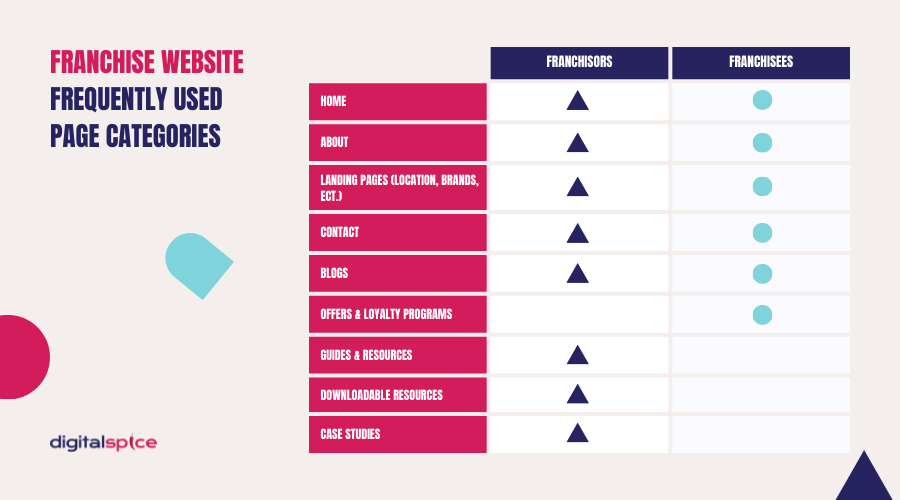
As every franchise is unique, this isn’t a definitive list, but you can use it to start your brainstorming session.
When you’ve decided on the content types and web pages you want to use, group them into landing page categories. These are usually featured in the main menu of the website as they are deemed most important for your users.
If you remember,
- For franchisor websites, these landing page categories will typically include the types of businesses and brands in your portfolio;
- For franchisees, these will typically include locations, menus/offering, and loyalty programs.
Finally, by grouping your pages into categories, you are beginning to organize them into a sensible sitemap.
Think about how your users will move from one page to another to streamline their journey through your website.

4. Optimize your content
Optimizing your website content for search engines involves two key elements:
- Understanding and addressing the search intent behind your targeted keywords.
- Applying user experience (UX) best practices to your content structure and formatting.
Let’s start with the search intent.
Once you’ve identified the keyword you want your web page to rank for, such as “Italian restaurants in Chicago,” you want to understand what the user wants to know when they search for that keyword on Google.
The best way to gain insights is to Google the keyword yourself.
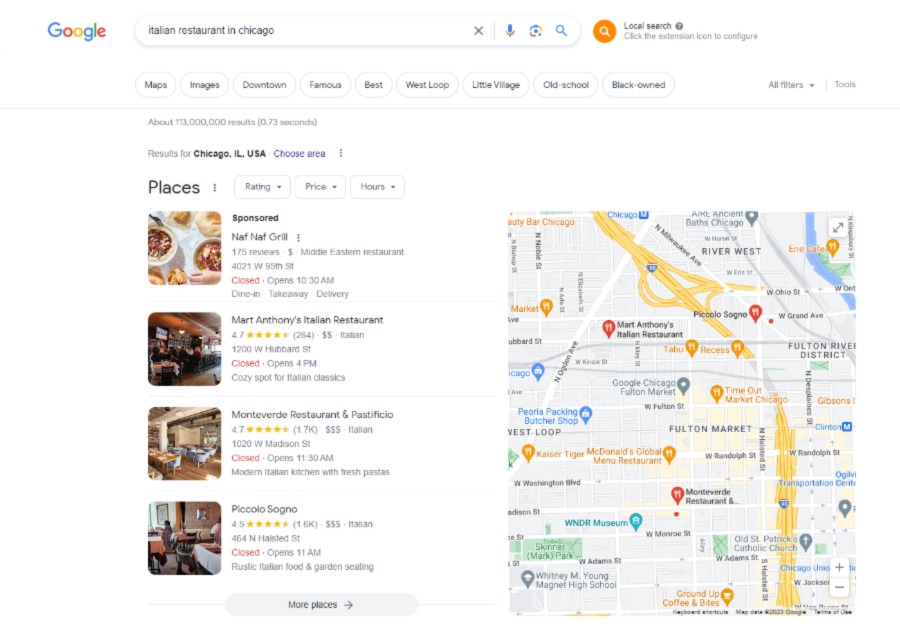
Google results for “italian restaurant in chicago” in Chicago, IL, June 2023
Scan the results on the first page and focus on the different result types that show up such as:
- map results
- featured snippets like definitions or lists
- rich results with additional links and previews
All of these insights indicate ranking opportunities for your content. (Remember that local pack and map results require a local SEO strategy which is rooted in your Google Business Profile. Click here to jump to the relevant section.)
Then, click on your top competitors’ landing pages and evaluate the type of information they provide.
Observe the modules they use and the information they offer their users. Google has already deemed these pages as relevant so use them as benchmarks for the type of content your users are seeking. Competitor insights should help you create an outline for your landing page that answers all facets of your target keyword’s search intent.
Now we get to the second element:
Applying UX best practices.
Once you start drafting your landing page, pay close attention to your HTML structure and formatting.
The most important element of the HTML structure to focus on are your headers.
Use header tags (H1, H2, H3, etc.) to structure your content. The main title should be a single H1 header, while the rest of the content can be organized under sub-headers or H2, which can be further broken down into H3s and H4s as needed.
Next, interlink your content.
Incorporate calls to action buttons to guide users to relevant pages and add links to other valuable resources on your website.
Finally, add visuals.
Visual elements like images, videos, and GIFs enhance the user experience, increasing engagement rates and time on page—metrics that indicate content quality and signal to Google that users find your content valuable.
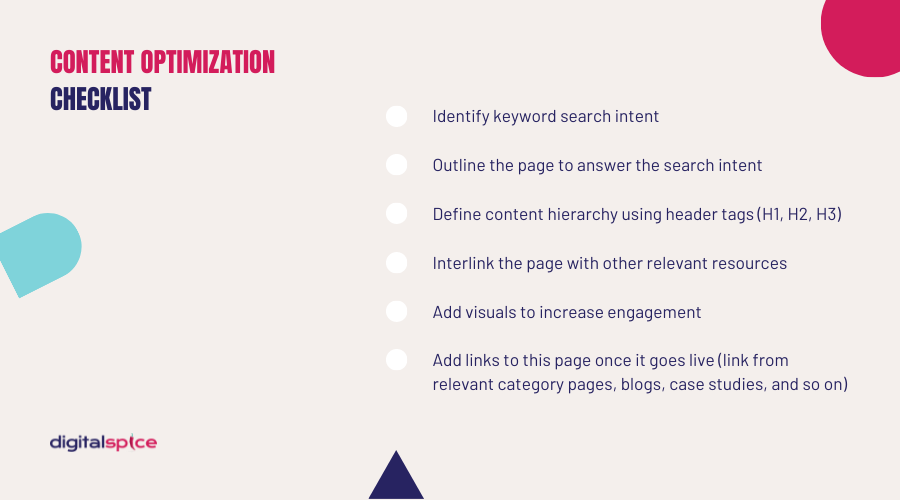
5. Streamline user journeys
User journeys are simply the paths that users take through your website and, as a brand, you want to guide your users towards completing the desired action, i.e. conversion.
A website conversion is a goal you assign and track in Google Analytics such as:
- Contacting your business development teams
- Purchasing a gift card
- Locating your nearest branch
- Entering your loyalty program
To facilitate these paths, two web design elements come into play: navigation and interlinking.
Navigation, frequently referred to as the “menu,” is the collection of links on your web pages, found primarily in the header and footer areas. It allows users to quickly access key sections of your website.
When constructing your main menu, consider the key page categories and pages that users need to see.
For franchisor websites like Sonesta Hotel Development, these page categories may be Brands, About, and Newsroom.

Sonesta Franchise Website designed by Digital Spice
Franchisees like Starbucks, on the other hand, will focus mainly on their shoppers.
Starbucks’ main navigation focuses on engaging local buyers and building loyalty, featuring links to their menu, rewards program, gift cards, and store locations.

Starbucks.com header navigation, July 2023
The brand uses its footer navigation to engage its secondary audience: prospective recruits.
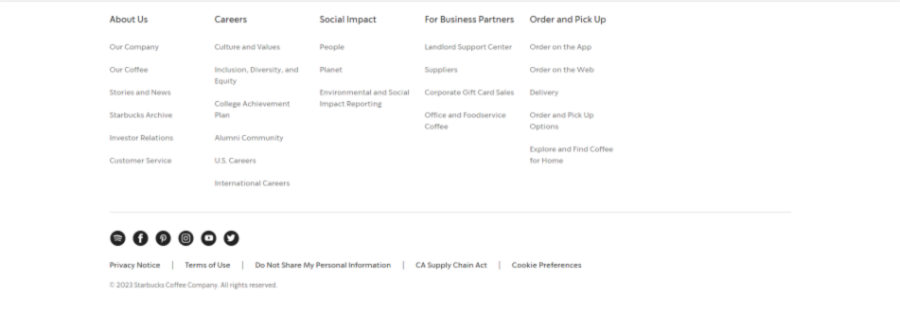
Starbucks.com footer navigation, July 2023
Now, let’s look at interlinking.
Interlinking plays an important role in SEO. It creates relationships between pages, building topical clusters and helping both users and search engines like Google discover related resources on your website.
Two primary methods can be used for interlinking: call-to-action (CTA) buttons and internal links.
CTAs are usually prominent visual elements on your page and, therefore, effective in attracting users’ attention and clicks. Place them strategically throughout your landing pages to lead users to more relevant content.
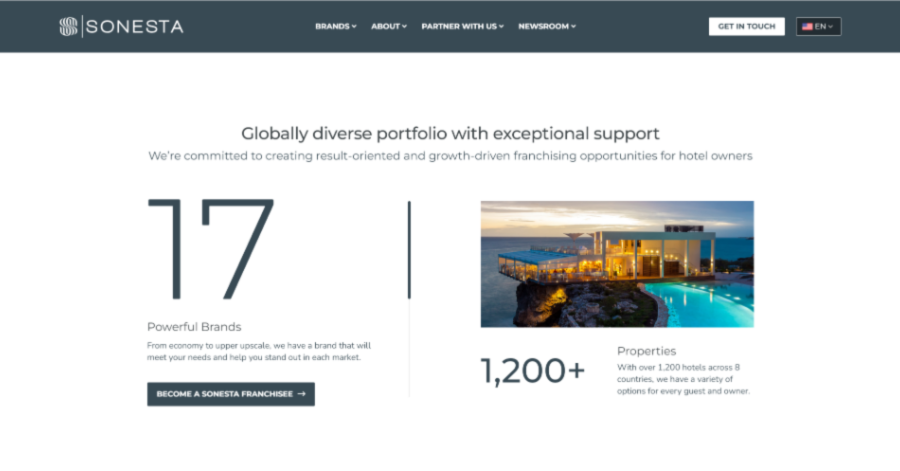
“Become a Sonesta franchisee” CTA stands out on franchise.sonesta.com landing page
Internal links are simply the links you feature in your paragraph text. Place your links on relevant anchor text to help your user understand what’s behind the click.
6. Create a scalable URL structure
In our experience, a disorganized URL structure is one of the most common mistakes franchise websites make.
Here’s why:
Content is a cornerstone of a franchise SEO growth strategy. Franchises need to create content, primarily valuable landing pages, to build topical authority and grow organic traffic.
To help users and search engines navigate your content clusters easily, you need interlinking and a scalable URL structure.
What does a scalable URL structure mean?
A scalable URL structure helps create logical relationships between related pages through streamlined URL paths.
You want to observe this best practice whether you have 1 or dozens of branches in any given location.
Here’s why!
Say you have only 1 franchisee in Chicago and decide to give that property a URL and SEO optimization that focuses on the whole city of Chicago.
What happens when you add more franchisees and expand your presence in Chicago?
You’ll run into keyword cannibalization. Multiple pages will be competing for the same keyword.
The solution?
The franchisor should own the entire state, city, and suburb pages that link out to relevant franchisee pages or microsites to collect and funnel relevant traffic.
What does this look like on a URL level
- https://www.example.com/locations/illinois/chicago/ – Franchisor page
- https://www.example.com/store/chicago-michigan-avenue/ – Franchisee page listed on franchisor page
This structure gives you the flexibility to target more location-based keywords regardless of the number of franchisees in the area.
For example, if we have multiple franchisees in the Chicago River North area, you can create an additional page:
https://www.example.com/locations/illinois/chicago/river-north/
Or we can create a point-of-interest-level page for a keyword that contains “near Art Insitute of Chicago,” like so:
https://www.example.com/locations/illinois/chicago/art-institute/
Here’s a real-world example:
Let’s take Sonesta.com, a renowned hotel chain, and our client.
One of the first elements we focused on in our SEO strategy for Sonesta was reorganizing its URL structure.
What did we do?
We created a parent-child page relationship between cities, points of interest, and location-based interest pages, and used them to link and funnel traffic to hotel pages.
Observe this sequence of Sonesta URLs for location pages:
- Parent Page: www.sonesta.com/locations/us/illinois/chicago/
Child Pages:
- https://www.sonesta.com/locations/us/illinois/chicago/navy-pier
- https://www.sonesta.com/locations/us/illinois/chicago/pet-friendly-hotels
- https://www.sonesta.com/locations/us/illinois/chicago/extended-stay-hotels
Now, observe the URLs of the hotel pages these locations are linking to:
- https://www.sonesta.com/royal-sonesta/il/chicago/royal-sonesta-chicago-downtown
- https://www.sonesta.com/royal-sonesta/il/chicago/royal-sonesta-chicago-river-north
- https://www.sonesta.com/sonesta-es-suites/il/chicago/sonesta-es-suites-chicago-downtown-magnificent-mile-medical
The hotel pages have unique URLs clustered principally around hotel brands, or “collections” as Sonesta calls them, and feature locations (…/il/chicago/…) to tell users and search engines alike where a hotel is located.
This structure allows us to rank location pages for local keywords and funnel the traffic these pages collect to individual hotel pages. As such, it is scalable and symbiotic.
7. Test your core web vitals thoroughly
Google has always been transparent about rewarding websites that provide a good user experience.2
Core web vitals are a set of user-centered metrics that measure the loading, interactivity, and visual stability of web pages.
Core web vitals consist of three key metrics:
- Largest Contentful Paint (LCP): LCP measures the time it takes for the largest piece of content on your webpage to become visible to the user. Aim for an LCP of 2.5 seconds or less to ensure a positive user experience.
- First Input Delay (FID): FID measures the responsiveness of your webpage by gauging the time it takes for the browser to respond to a user’s first interaction. Aim for an FID of 100 milliseconds or less to ensure smooth user interaction.
- Cumulative Layout Shift (CLS): CLS measures the visual stability of your webpage by calculating the amount of unexpected layout shifts that occur during page loading. Aim for a CLS score of 0.1 or less to prevent frustrating visual disruptions.
Core web vitals have become a significant ranking factor for search engines. Google in particular has been vocal about prioritizing websites with fully optimized core web vital metrics.
As you are developing and preparing to launch your franchise website, run a thorough QA:
- Utilize Web Vitals Tools: Leverage tools such as Google’s PageSpeed Insights, Lighthouse, or Chrome User Experience Report to assess your website’s core web vitals performance. These tools provide detailed reports, highlighting areas that require improvement.
- Optimize Page Speed: Compress images, minify CSS and JavaScript files, and enable browser caching to improve your website’s loading speed, thereby enhancing LCP and FID metrics.
- Minimize Layout Shifts: Ensure that all elements on your webpage have specified dimensions to prevent sudden layout shifts. Prioritize loading above-the-fold content first to avoid unexpected CLS.
Once your website is live, regularly monitor your website’s core web vitals. As new content or updates are implemented, assess the impact on these metrics and make necessary adjustments to keep your health scores high.
As you might have guessed, optimizing a website for SEO is nothing more than optimizing your user experience (UX).
Need a technical SEO audit? Our experts can help! →
Part #2. Preparing Your Franchise for Local SEO
If you are looking to leverage SEO to grow foot traffic at your local branches, local SEO should be integral to your marketing strategy.
Local SEO helps you market your local branches online by optimizing your presence on Google Maps, local pack, and organic search results.
A quick side note: Why are we focusing on Google?
With a 93%3 search engine market share, focusing your local SEO strategy on Google, and particularly Google Maps, is a no-brainer.
The local pack, or local finder, is a section within Google’s search results that displays a map and relevant local businesses for location-based queries. It helps users find and compare local businesses quickly with key information like ratings and contact details.
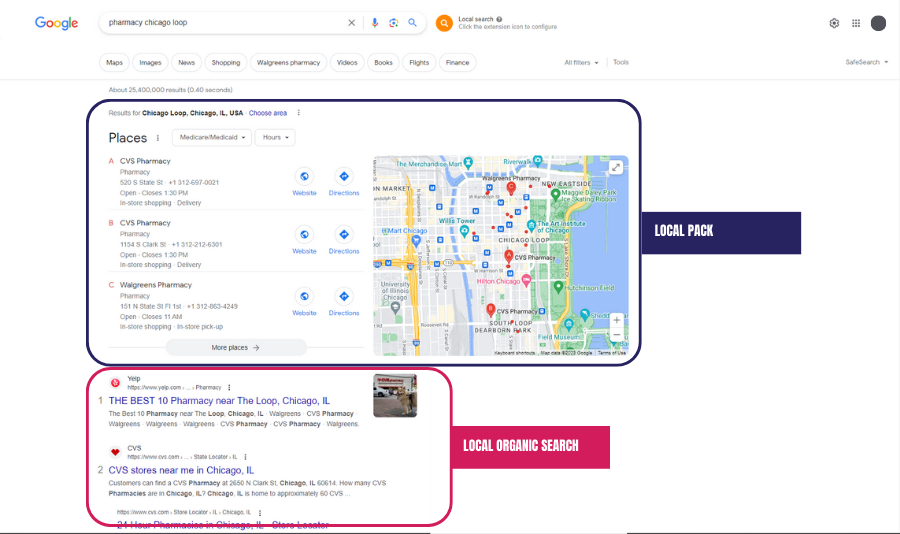
Here’s an example of a local search result for “pharmacy chicago loop” keyword
Local organic results are the non-paid search listings that appear below the local pack or separately on the search engine results page. These results are influenced by SEO factors and provide relevant website listings based on the user’s search query, driving organic traffic to the franchise’s website.
How do you get your locations to pop up for “near me” and similar local searches?
Google focuses on three criteria to rank businesses for local searches, both in organic results and local pack results:
1. Proximity
Proximity refers to the physical distance between the searcher and the business location. Google aims to provide users with results that are geographically closest to their current location.
The closer a franchise is to a user’s search location, the higher its chances of appearing in local search results.
2. Relevance
Relevance focuses on how well a franchise’s business profile matches the user’s search query. Google analyzes various factors, including the business category, keywords, website content, and customer reviews, to assess relevance.
Franchises should ensure that their business profile and website content are optimized with relevant keywords and accurate information.
3. Prominence
Prominence refers to the overall popularity, visibility, and reputation of a franchise both online and offline. Google takes into account factors like customer ratings, reviews, online presence, and traditional media mentions.
Franchises with a strong online presence, positive reviews, and high engagement are more likely to rank higher in local search results.
As you may imagine, local pack results are highly convenient to users as they can simply click and map themselves to their desired locations. This makes them powerful at driving foot traffic to your franchise’s local branches.
Here’s a quick overview of eight signals that factor into local pack rankings:
Google Business Profile (GBP) Signals
- Proximity: The distance between the searcher and the franchise location
- Categories: The relevance of the chosen categories for the franchise
- Keyword in Business Title: The presence of relevant keywords in the business title
Link Signals
- Inbound Anchor Text: The text used by other websites when linking to the franchise’s website
- Linking Domain Authority: The authority and quality of websites linking to the franchise’s website
- Linking Domain Quantity: The number of websites linking to the franchise’s website
Review Signals
- Review Quantity: The number of reviews received by the franchise
- Review Velocity: The frequency at which new reviews are generated
- Review Diversity: The variety of review platforms used by customers to review the franchise
On-Page Signals
- Presence of NAP (Name, Address, Phone): Consistent and accurate representation of the franchise’s NAP information on its website
- Keywords in Titles: The use of relevant keywords in page titles
- Domain Authority: The overall authority and credibility of the franchise’s website
Citation Signals
- IYP/Aggregator NAP Consistency: The consistency of the franchise’s Name, Address, and Phone information across online directories
- Citation Volume: The number of online directories or citations referencing the franchise
Behavioral Signals
- Click-Through Rate: The percentage of users who click on the franchise’s listing in search results
- Mobile Clicks to Call: The number of users who click to call the franchise directly from mobile search result
- Check-Ins: The frequency of users checking in at the franchise’s location on social platforms
Personalization
- User’s Online Behavior: The individual user’s search history, bookmarks, and preferences influencing search results
Social Signals
- Google Engagement: The level of engagement with the franchise’s Google My Business listing
- Facebook Engagement: The level of engagement on the franchise’s Facebook page
- Twitter Engagement: The level of engagement on the franchise’s Twitter account
Get a free proposal for your local SEO project →
There you have it:
Creating a user-friendly website and fully optimized GBPs for your local branches are your foundational elements to growing visibility on search engines and foot traffic to your physical locations.
HOW TO GROW YOUR FRANCHISE SEO
Now that you have created a healthy and fruitful environment for your franchise SEO, you will need to employ strategies and routine practices to grow your SEO results over time.
Growing Your Franchise Website SEO
To nurture and grow your website’s SEO performance, you need to:
- Create valuable, topically relevant content
- Run regular technical audits
- Cluster topically related content via interlinking
- Gain relevant and quality backlinks
- Report on and analyze your progress regularly
- Audit and reoptimize your content once or twice per year
Let’s break these down:
1. Content Creation
An average B2B buyer views 8 pieces of your content before making a purchasing decision.4
We don’t know what this number may be for B2C consumers as buyer journeys can vary greatly, nevertheless, research shows that content is powerful at building authority and trust.
Search engines like Google understand this.
In fact, Google is likely to reward websites that produce topically focused and relevant content as they demonstrate domain expertise.
What does this mean for your franchise?
Create a content strategy focused on domain expertise and answering your audience’s needs.
Say you are looking to attract real estate agents to join your local branch. What content would be most relevant to your audience?
Think:
- Category pages for local neighborhoods
- Landing pages for local listings
- Reports and guides on the local real estate trends
Supplement your content strategy with a keyword strategy to create a content plan that attracts audiences through engines and engages them on the website.
Keyword research and strategic topic selection will help you identify the content that has the potential to attract audiences via search engines.
2. Technical Audits
As your website grows, its performance and “health” may change, directly impacting your SEO.
Regular technical audits will help you identify and remove any roadblocks to your website’s SEO growth.
Pay attention to factors such as website speed, mobile responsiveness, and URL structure.
Optimize your website’s technical elements to ensure that search engines can crawl and index your pages effectively.
3. Internal Linking
Internal linking helps you connect relevant resources for users and search engines alike.
Imagine you are a retail franchise looking to attract franchisors. Your brand-unaware user lands on your guide on “how to start a retail business“ via Google.

Search volume for “how to start a retail business,“ Ahrefs, July, 2023
Where would you lead them next?
Here are a few ideas:
- Your retail franchising landing page
- Your retail franchising case studies
- Your retail franchising reports
- Your other relevant guides like “how to budget for your retail business” or “how to recruit the right people for your retail business,” and so on.
Create a network of interlinked pages within your website that focus on specific topics related to your franchise.
Linking relevant pages together also helps search engines connect semantically relevant topics and understand your domain expertise which, in turn, enhances the visibility of your content.
4. Backlinks
If internal links lead users to other pages or pieces of content within your website, backlinks lead users from other websites to yours.

The recognition other websites give you by referencing your content tells Google that you are a trustworthy and authoritative source.
As you can imagine, backlinks deliver valuable SEO juice to your website.
Focus on building relationships with other businesses, industry influencers, and local directories.
Guest blogging, participating in industry events, and leveraging social media platforms are effective methods to gain recognition and acquire high-quality backlinks.
5. Reporting
It goes without saying that strategizing without data is like throwing darts in the dark. You may luck out and hit the bullseye once, but it is highly unlikely that it will happen again.
Regular reporting, both weekly and monthly performance overviews, will help you identify roadblocks as well as untapped opportunities, evaluate your strategy, and evolve your approach.
Utilize SEO analytics tools to monitor key metrics such as organic traffic, keyword rankings, and user engagement.
The same tools can help you look to your competitors for benchmarking as well as inspiration.
6. Audits
More than 6 million logs go live every single day.5
Why should you care?
This massive daily influx of content means that the SEO landscape changes by the day and more relevant resources may enter the race for your target keywords.
Running periodic content audits is essential to keep your franchise website’s content fresh, relevant, and competitive.
Designate time twice a year to audit your blogs, landing pages, and other SEO resources for relevance and accuracy.
Identify outdated or underperforming pages and plan the necessary updates or improvements.
We usually recommend running audits in late November to plan content updates for the following year, as well as one in late June to identify opportunities for reoptimization and performance improvements.
Growing Your Franchise’s Local SEO
Much like website SEO, growing your local SEO results requires continuous work, including:
- Managing your GBP
- Managing your online reputation, especially reviews
- Reporting
Let’s break these down:
1. GBP Management
To grow your visibility for local pack and map searches, keep your GBP up-to-date and alive.
Ensure that your location, work hours, holidays, and links are correct.
Regularly refresh your photos and release updates your visitors may find relevant.
Interact with your users by answering their questions, acknowledging positive reviews, and showing care for their complaints and concerns.
Here’s a short and useful Google guide to managing your GBP.
2. Online Reputation Management
Between April 2021 and February 2023, Google released 6 algorithm updates related to reviews.6
This tells us that Google sees your reviews and Google cares about your reviews a lot.
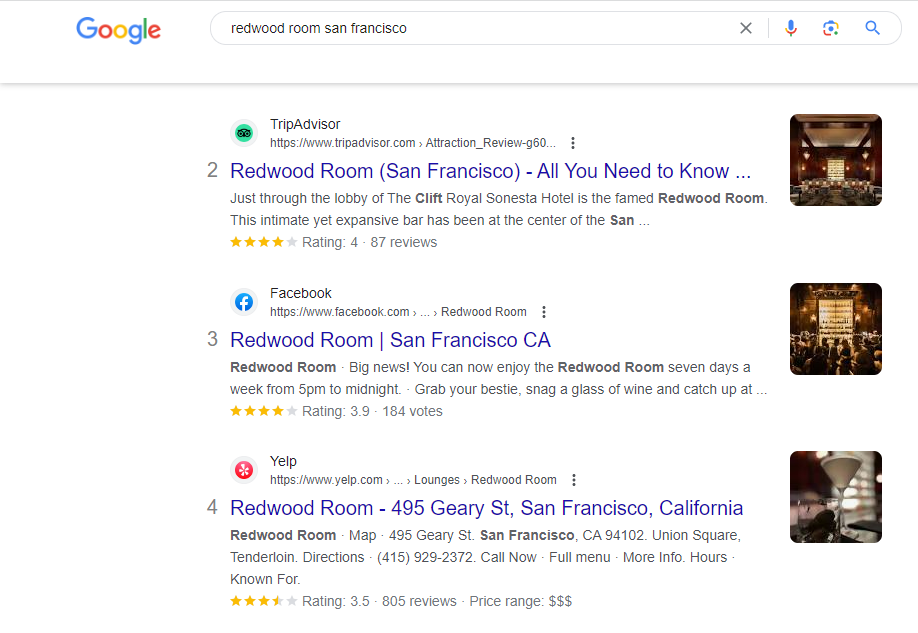
An example of reviews in SERPs
How do you manage your reviews?
Enter online reputation management (ORM).
ORM is a digital marketing strategy focused on improving how users perceive your brand. As such, ORM directly impacts your brand’s credibility and, as Google’s algorithm updates show, your entire SEO.
In practice, ORM overlaps with other strategies including website and social media, so online reputation managers (ORMs) will collaborate with other teams to prioritize and orchestrate reputation management campaigns.
When it comes to day-to-day, ORMs will focus on incentivizing and managing reviews and other user-generated content on review sites, from GBP to Yelp, G2, TrustPilot, and your own website.
From website and local SEO to facilitating purchasing decisions, your franchise can optimize its entire conversion funnel by enhancing brand reputation via user reviews.
3. Reporting
GBP comes with in-built analytics that can show you how users find your profile as well as interact with it.
You can observe insights such as which keywords people use to find you, how many viewers you had in a given timeframe, how many direction requests, clicks to call, menu views, and other interactions you have had on your profile.
As with website SEO, we recommend producing your local SEO reports both weekly and monthly for optimal results.
Here’s a Google guide to checking your GBP performance & insights.
HOW TO FUTUREPROOF YOUR FRANCHISE SEO
The future of SEO is largely speculative.
With generative AI tools coming into the market and evolving by the day, no one knows what search engines will look like in the next 2-3 years.
While we cannot be sure what these new AI-driven technologies might do for SEO and how they may shape Google Search engine results, one thing is for certain:
Google, like other search engines, will continue to prioritize their user experience.
Every update they make to their search experience will be in service of delivering the best possible value and results to their users’ queries.
To futureproof your franchise SEO, we recommend focusing on your user and applying best practices to your franchise website as well as other channels.
As a general vision for your SEO strategy, we recommend to:
- Serve Your Audience
- Grow Your Community
- Make Friends with Generative AI
Let’s unpack this:
1. Serve your audience
Serving your audience simply means anticipating and understanding your audience’s queries and delivering optimal solutions to them.
This is why keyword research will continue to play an important role in SEO. It helps you understand what users are looking for, how many of them are searching for a given keyword per month, and what the competition for that keyword is.
Among other metrics, understanding search volumes around the keyword will help you identify the topics that your audience is truly interested in, but your topic search should not end there.
Keyword research will give you an insight into the total potential audience you can hope to attract as well as the value you can provide them with as a domain expert, but to achieve this you need to understand what your audience wants to know when they Google a specific keyword.
When creating your content plan for your website or Google Business profile, always put your audience first. Anticipate their needs and provide valuable content that answers their queries.
2. Create a community
Google is increasingly leveraging users’ interactions with your brand as a sign of content quality and brand credibility.
We know that the longer a user stays on your website, the more they interact, and the better the reviews they leave, the better your SEO performance.
Besides driving awareness, focus on building an engaged community across your owned and earned channels.
From growing your website’s visitor retention to sparking conversations online, your audience is the best judge of the value your brand (and content!) brings to the table and Google trusts their judgment.
3. Make friends with AI tools
Love them or hate them, no SEO expert can ignore the profound impact generative AI tools are already having on our industry.
While generative AI tools may still have a few kinks to work out, from hallucinations—a term that describes any output that may be irrelevant or inaccurate—to subpar content, they are evolving rapidly and will soon become integral to how we strategize and implement SEO plans.
The biggest value that generative AI tools bring to your website and SEO is efficiency.
Take large language modeling tools like ChatGPT and Jasper.ai.
These tools can produce 1,000 words of unique content in minutes (if not seconds), while a professional content writer may need hours to physically type the text.
At Digital Spice, we treat AI tools as our talented interns who free up our content specialists’ time for brainstorming unique, creative, and valuable content ideas.
You would never use interns’ work without thorough reviews and fact-checking.
So, AI tools can help you produce content faster, but much like interns, they need clear prompts, thorough fact-checking, and revisions.
In summary: To futureproof your franchise website’s SEO, put your audience first. Provide your audience with the content and experience they seek.
To win with Google, think & act like Google.
PARTNER WITH OUR FRANCHISE SEO EXPERTS
Digital Spice is a full-service agency with a proven track record in helping franchises drive measurable results online.
From branding to custom websites and SEO, we’ve worked with franchises across industries to build and grow their online presence.
Click here to request a free proposal for your franchise SEO project.
References:
1 Sterling, G. (2021, August 27). Study: 78 Percent Of Local-Mobile Searches Result In Offline Purchases. Search Engine Land. https://searchengineland.com/study-78-percent-local-mobile-searches-result-offline-purchases-188660
2 The role of page experience in creating helpful content | Google Search Central Blog | Google for Developers. (n.d.). Google for Developers. https://developers.google.com/search/blog/2023/04/page-experience-in-search?hl=en
3 Search Engine Market Share Worldwide | Statcounter Global Stats. (n.d.). StatCounter Global Stats. https://gs.statcounter.com/search-engine-market-share
4 Content Really is King: Content Consumption in the B2B Buyer’s Journey. (2020). FocusVision. Retrieved June 30, 2023, from https://cloud.kapostcontent.net/pub/ed24339d-0b16-4341-8fef-c4d921903f8c/whitepaper-marketing-content-consumption-study
5 How Many Blogs Are There? We Counted Them All! (2023, March 4). WebTribunal. https://webtribunal.net/blog/how-many-blogs/#gref
6 Schwartz, B. (2023, April 25). Google April 2023 reviews update is finished rolling out. Search Engine Land. https://searchengineland.com/google-april-2023-reviews-update-is-finished-rolling-out-395916#:~:text=The%20first%20product%20reviews%20update,released%20on%20February%2021%2C%202023








